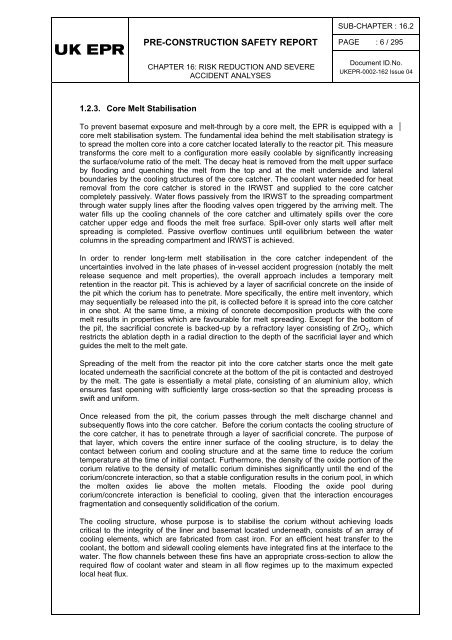16.2 - Severe Accident Analysis (RRC-B) - EDF Hinkley Point
16.2 - Severe Accident Analysis (RRC-B) - EDF Hinkley Point
16.2 - Severe Accident Analysis (RRC-B) - EDF Hinkley Point
Create successful ePaper yourself
Turn your PDF publications into a flip-book with our unique Google optimized e-Paper software.
SUB-CHAPTER : <strong>16.2</strong>PRE-CONSTRUCTION SAFETY REPORTCHAPTER 16: RISK REDUCTION AND SEVEREACCIDENT ANALYSESPAGE : 6 / 295Document ID.No.UKEPR-0002-162 Issue 041.2.3. Core Melt StabilisationTo prevent basemat exposure and melt-through by a core melt, the EPR is equipped with acore melt stabilisation system. The fundamental idea behind the melt stabilisation strategy isto spread the molten core into a core catcher located laterally to the reactor pit. This measuretransforms the core melt to a configuration more easily coolable by significantly increasingthe surface/volume ratio of the melt. The decay heat is removed from the melt upper surfaceby flooding and quenching the melt from the top and at the melt underside and lateralboundaries by the cooling structures of the core catcher. The coolant water needed for heatremoval from the core catcher is stored in the IRWST and supplied to the core catchercompletely passively. Water flows passively from the IRWST to the spreading compartmentthrough water supply lines after the flooding valves open triggered by the arriving melt. Thewater fills up the cooling channels of the core catcher and ultimately spills over the corecatcher upper edge and floods the melt free surface. Spill-over only starts well after meltspreading is completed. Passive overflow continues until equilibrium between the watercolumns in the spreading compartment and IRWST is achieved.In order to render long-term melt stabilisation in the core catcher independent of theuncertainties involved in the late phases of in-vessel accident progression (notably the meltrelease sequence and melt properties), the overall approach includes a temporary meltretention in the reactor pit. This is achieved by a layer of sacrificial concrete on the inside ofthe pit which the corium has to penetrate. More specifically, the entire melt inventory, whichmay sequentially be released into the pit, is collected before it is spread into the core catcherin one shot. At the same time, a mixing of concrete decomposition products with the coremelt results in properties which are favourable for melt spreading. Except for the bottom ofthe pit, the sacrificial concrete is backed-up by a refractory layer consisting of ZrO 2 , whichrestricts the ablation depth in a radial direction to the depth of the sacrificial layer and whichguides the melt to the melt gate.Spreading of the melt from the reactor pit into the core catcher starts once the melt gatelocated underneath the sacrificial concrete at the bottom of the pit is contacted and destroyedby the melt. The gate is essentially a metal plate, consisting of an aluminium alloy, whichensures fast opening with sufficiently large cross-section so that the spreading process isswift and uniform.Once released from the pit, the corium passes through the melt discharge channel andsubsequently flows into the core catcher. Before the corium contacts the cooling structure ofthe core catcher, it has to penetrate through a layer of sacrificial concrete. The purpose ofthat layer, which covers the entire inner surface of the cooling structure, is to delay thecontact between corium and cooling structure and at the same time to reduce the coriumtemperature at the time of initial contact. Furthermore, the density of the oxide portion of thecorium relative to the density of metallic corium diminishes significantly until the end of thecorium/concrete interaction, so that a stable configuration results in the corium pool, in whichthe molten oxides lie above the molten metals. Flooding the oxide pool duringcorium/concrete interaction is beneficial to cooling, given that the interaction encouragesfragmentation and consequently solidification of the corium.The cooling structure, whose purpose is to stabilise the corium without achieving loadscritical to the integrity of the liner and basemat located underneath, consists of an array ofcooling elements, which are fabricated from cast iron. For an efficient heat transfer to thecoolant, the bottom and sidewall cooling elements have integrated fins at the interface to thewater. The flow channels between these fins have an appropriate cross-section to allow therequired flow of coolant water and steam in all flow regimes up to the maximum expectedlocal heat flux.













![6.3 - Safety Injection System (RIS [SIS]) - EDF Hinkley Point](https://img.yumpu.com/42739985/1/184x260/63-safety-injection-system-ris-sis-edf-hinkley-point.jpg?quality=85)


